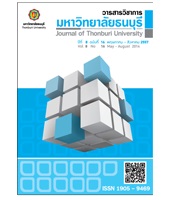การประยุกต์ใช้เทคนิคการออกแบบการทดลองในการผสมพอลิพลอลีนกับยางอนุภาคนาโน
Keywords:
การทดลองเชิงแฟคทอเรียล, กระบวนการผสมวัสดุเชิงประกอบ, ยางอนุภาคนาโน, factorial design, composite material mixing, Nano rubberAbstract
งานวิจัยนี้มีวัตถุประสงค์เพื่อศึกษาหาปัจจัยและระดับที่เหมาะสมในการผสมและขึ้นรูปชิ้นงานทดสอบของวัสดุเชิงประกอบระหว่างพอลิพรอพิลีนกับยางอนุภาคนาโนโดยประยุกต์ใช้เทคนิคการออกแบบการทดลอง เพื่อเพิ่มคุณสมบัติด้านความเหนียวของพอลิพรอพิลีน ในการทดลองครั้งนี้ใช้ยางอนุภาคนาโนมาเป็นสารตัวเติมตามสัดส่วนพอลิพรอพิลีนต่อยางอนุภาคนาโนที่ 100: 0, 99.5: 0.5, 99:1, 98.5:1.5 และ 98:2 ชิ้นงานที่ใช้ทดสอบมีขนาดตามมาตรฐาน ASTM D 638 Type IV และ ASTM D 256 โดยออกแบบการทดลองเป็นแบบ General Factorial ประกอบด้วย 3 ปัจจัยหลักได้แก่ ปริมาณยางอนุภาคนาโนโดยน้ำหนักที่ 0.5, 1, 1.5 และ 2 เปอร์เซ็นต์ ความเร็วรอบในการผสมที่ 40, 60 และ 80 รอบต่อนาที และอุณหภูมิในการผสมที่ 180 และ 200 oC ตัวแปรตอบสนองคือค่าการต้านทานต่อแรงดึงและค่าการต้านทานต่อแรงกระแทก ทำการศึกษาผลกระทบหลักและผลกระทบร่วมของปัจจัยต่างๆโดยใช้วิธีวิเคราะห์ผล ANOVA ที่ระดับความเชื่อมั่น 95 % จากผลการทดลองและวิเคราะห์ทางสถิติพบว่าปัจจัยและระดับที่เหมาะสมในการผสมและขึ้นรูปชิ้นงานทดสอบของวัสดุเชิงประกอบระหว่างพอลิพรอพิลีนกับยางอนุภาคนาโนคือที่ปริมาณยางอนุภาคนาโน 1 เปอร์เซ็นต์ โดยน้ำหนัก ความเร็วรอบในการผสมที่ 40 รอบต่อนาที อุณหภูมิในการผสม 180 oC ค่าการต้านทานแรงดึงเท่ากับ 52 MPa และค่าการต้านทานแรงกระแทกเท่ากับ 32.55 kJ/m2 ผลการทดลองดังกล่าวเป็นแนวทางนำไปสู่การพัฒนาการผลิตวัสดุเชิงประกอบกับพลาสติกชนิดต่างๆเพื่อให้ตอบสนองกับความต้องการใช้พลาสติกในอนาคตต่อไป
BY USING DESIGE OF EXPERIMENT (DOE) TECHNIQUE IN MIXING OF POLYPROPYLENE WITH NANO RUBBER
The objective of this research is to identify the optimal factors in mixing composite material between polypropylene and nano rubber by using design of experiment (DOE) technique in order to increase the toughness of the polypropylene. The experiment was conducted by mixing polypropylene with the nano rubber as filler at proportion of 100: 0, 99.5: 0.5, 99:1, 98.5:1.5 and 98:2 The specimens were tested according to ASTM D 638 Type IV and ASTM D 256 Standard. The general factorial design was used to investigate the behavior of materials based on three main factors; (1) nano rubber by weight at 0.5, 1, 1.5 and 2% (2) speed of mixing at 40, 60 and 80 rpm and (3) Temperature at 180 oC and 200 oC. The responses were considered by performing tension and shear. The ANOVA was used to statistically analyze the main impact and interaction impact among three factors at the confidence level at 95 percent. The results showed that the most appropriate factors are the rubber particles of 1% by weight, at mixing speed from 40 rpm and the temperature of 180 C. The tensile strength is 52 MPa and impact strength is 32.55 kJ/m2. Result of this research can be used as a line to the development of composite materials of various plastics to meet the demand of plastic use in the future.







